Table of Contents
Looking for the best time to post on Facebook for maximum likes, comments, shares, and results?
The Hootsuite team partnered with data science agency Critical Truth for a comprehensive study. We analyzed over 1 million social posts — across industries and social networks — and we found the definitive best times to post on Facebook for maximum engagement.
Keep reading for the most recent available data (collected in Q4 of 2024).
Note: Unless stated otherwise, the time of day was localized across 118 countries where sample data came from, i.e. the graphs below are accurate across time zones.
What time is the best time to post on Facebook in 2025?
We analyzed thousands of posts on social media and dug deep into industry data to determine…
The best top time to post on Facebook for maximum engagement is 5:00 AM on Tuesdays.

Of course, you’ll need to think about the time zones in which your audience lives when planning these posting times.
What time is best to post on Facebook by day of the week?
In addition to the best time of day, you need to think about which days of the week make the most sense for publishing your content.
For example, the Hootsuite social team finds that Mondays through Wednesdays are the most effective days to post on Facebook.
That doesn’t mean Hootsuite only posts Mondays through Wednesdays. You just have to think strategically about ways to boost relevance and engagement on those non-peak days.
Hootsuite’s Social Media Marketing Coordinator, Eileen Kwok, adds that you can help boost engagement on non-peak days with specific copywriting techniques:
“Writing copy that is relevant to the day of the week can help boost engagement,” says Eileen Kwok, Hootsuite’s Social and Influencer Marketing Strategist. “For example, on Friday mid-morning, posting something like, PSA: Remember to schedule your posts for the weekend would be a helpful reminder to our audience.”
With all that said, here are the peak optimal times to post on Facebook day by day:
| Day of the week | Best time to post on Facebook |
| Monday | 5:00 PM |
| Tuesday | 5:00 AM |
| Wednesday | 6:00 AM |
| Thursday | 6:00 AM |
| Friday | 6:00 AM |
| Saturday | 6:00 AM |
| Sunday | 8:00 AM |
Find your own custom Facebook heatmap with Hootsuite’s best time to post tool.
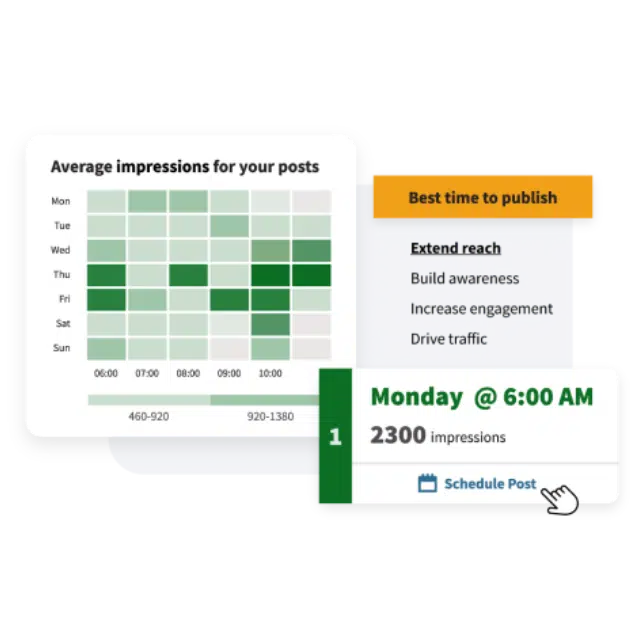
Find out when your audience is online and optimize your posting schedule for maximum engagement. It’s so easy.
Start free 30-day trialThe best time to post on Facebook for 13 industries
Your industry defines your audience, and different audiences interact with Facebook content on different schedules. Below, you’ll find the best times to post on Facebook across 13 major industries.
Note: This time of day data was localized across 118 countries where sample data came from, i.e. the graphs are accurate across time zones.
Construction, mining, and manufacturing
The best time to post on Facebook in the construction, mining, and manufacturing industry is 10 am to 12 pm on Thursdays.

Consumer goods and retail
The best times to post on Facebook in consumer goods and retail are:
- 5 pm to 6 pm on Tuesdays and Thursdays
- 8 am to 10 am from Wednesday to Saturday

Dining, hospitality, and tourism
The best time to post on Facebook in the dining, hospitality, and tourism industry is 10 am to 12 pm on Sundays. (Brunch, anyone?)

Education
The best times to post on Facebook in the education sector are:
- 1 pm to 3 pm on Mondays
- 5 pm on Tuesdays
- 11 am to 1 pm on Thursdays

Financial services
The best times for financial institutions to post on Facebook are:
- 4 pm to 6 pm on Tuesdays
- 3 pm on Wednesdays
- 9 am to 12 pm on Thursdays

Government
The best times to post on Facebook for government agencies and officials fall on weekends:
- 9 am to 6 pm on Saturdays
- 9 am to 12 pm on Sundays

Healthcare, pharma, and biotech
The best time to post on Facebook for organizations in the healthcare sector is 11 am to 1 pm on Saturdays.

Marketing agencies
The best time for marketing agencies to post on Facebook is 2 pm to 6 pm on Thursdays.

Media and entertainment
The best time to post on Facebook in the media and entertainment industry is early morning on Thursdays and Saturdays.

Nonprofit
The best time to post on Facebook for nonprofit organizations is 10 am to 4 pm from Monday to Wednesday.

Real estate, legal, and professional services
The best times to post on Facebook in professional services is 5 pm on Thursdays.

Technology
The best times to post on Facebook in the technology industry are:
- 12 pm on Wednesdays
- 11 am to 5 pm on Thursdays

Utilities and energy
The best time to post on Facebook in the utilities and energy industry is 3 pm to 5 pm on Mondays.

Best times to post on Facebook for 10 time zones
Arabia Standard Time
The best times to post on Facebook in Arabia Standard time are:
- 3 pm on Tuesdays
- 2 pm on Thursdays
- 4 pm on Fridays

Atlantic Standard Time
In AST, engagement is consistent throughout the week, between 10 am and 9 PM.

Central European Time
In CET, the best times to post on Facebook are:
- 10 am – 1pm on Tuesdays
- 6 am – 9 am on Wednesdays
- 5 am to 7 am on Thursdays
- 5 am to 7 am on Saturdays
- 11 am on Sundays

Central Standard Time
In CT, mornings and evenings generate consistent engagement throughout the week. 7 pm on Wednesdays seems to be the sweet spot.

Eastern Standard Time
Weeknights work best in EST. The best times to post on Facebook are 7 pm to 9 pm on Mondays and Wednesdays.

Japan Standard Time
In JST, the best time to post on Facebook is 2 pm to 4 pm on Wednesdays.

Mountain Standard Time
In CT, 5 pm from Monday to Wednesday is the best time to post on Facebook — but mornings and evenings generate consistent engagement throughout the week.

Newfoundland Time
The best times to post on Facebook are midday Monday to Saturday and 9 pm on Tuesdays and Thursdays.

Pacific Standard Time
The best time to post on Facebook in PST is 5 pm on Mondays and Wednesdays.

Coordinated Universal Time
The best time to post on Facebook in UTC is 1 pm to 7 pm on Sundays.

What affects the best time to post on Facebook?
Every business will see different peaks and dips regarding the best time to post a Facebook post. Here are a few things to keep in mind when planning your posting cadence.
Your unique audience
Audience behavior is one of the biggest determiners of your best time of day to post on Facebook.
Does your audience work a standard 9-5 Monday through Friday schedule? If so, your audience is most active at night than during the day.
Or, maybe they are stay-at-home parents who check Facebook throughout the day. Understanding when your audience is online can help you time your posts for maximum engagement.
Consider the following when planning your Facebook posts:
- Age: Different age groups use Facebook differently. Millennials make up almost half of Facebook’s audience, but middle- or lower-income teens are more likely to use Facebook than teens from higher-earning families.
- Work: Professionals might check Facebook during commute times, lunch breaks, or in the evenings. Those with flexible or non-traditional work hours might be active at different times throughout the day.
- Location: Location matters. Posting at times that align with your audience’s location ensures your content reaches them when they’re online. If your audience is global, consider posting at times that can catch multiple time zones.
Your industry
Different industries have different peak times for engagement. So, how do you go about finding out when your audience is online? Well, tapping into competitor data is a good place to start.
Start by conducting a social media competitor analysis. This involves looking at your competitors’ posting schedules and engagement rates to identify patterns and opportunities.
Here’s how to do it:
- Identify key competitors: Choose competitors who have a similar audience and product offering.
- Track their posting times: Note the times of day and days of the week they post.
- Measure engagement: Observe the likes, comments, shares, and other engagement metrics their posts receive.
- Identify patterns: Look for trends in their posting and engagement. Are there certain times of day or days of the week when their posts consistently perform well?
Pro Tip: Use Hootsuite’s industry benchmarking tool to see when competitors in your field are posting and getting high engagement. This can provide valuable insights into the best times to schedule your own posts.
Updates to the Facebook algorithm
Over the years, Facebook has continuously refined its algorithm, tweaking and updating ranking signals to ensure users see content that matters most to them.
Understanding how the algorithm works can help you use it to your advantage. And, time your Facebook posts to get more engagement.
As of 2024, the Facebook algorithm operates on four primary ranking signals:
- Source of the post: The algorithm prioritizes content from sources with which you frequently interact. This includes posts from friends, pages you follow, and businesses your audience engages with regularly.
- Type of content: Your interaction history determines the type of content your audience sees more of. If you engage more with videos, your feed will feature more videos. Likewise, if you interact with photos or text updates, those will appear more frequently.
- Likelihood of engagement: The algorithm predicts how likely users are to engage with a particular post. Factors such as previous interactions (likes, comments, shares), post type, and content relevance influence this prediction. Posts with higher predicted engagement are prioritized in your feed.
- Potential for meaningful interactions: Facebook aims to foster meaningful social interactions. Therefore, posts that are expected to generate valuable interactions among users — such as comments, shares, and replies — are ranked higher. This ensures that content sparking conversations and connections takes precedence.
Pro Tip: Stay updated with Meta’s algorithm changes on the Hootsuite blog.
Geographical trends and events
Geographical trends and events can have a big impact on when your audience is online and how they engage with your posts.
Local holidays, events, and even weather conditions can influence when people use Facebook.
For example, if there’s a major local event like a football game or a music festival, your audience might be online more frequently to share their experiences and connect with friends.
Or, during the month of Ramadan, food-related posts might do better or worse depending on the time of day.
Holidays can also play a significant role. During the holiday season, people might be more active online looking for gift ideas, shopping deals, or holiday recipes. On the flip side, they might also be spending more time with family and less time on social media.
Pro Tip: Keep an eye on local and global events that might affect your audience’s online habits with Hootsuite’s complete list of social media holidays.
Adjust your posting schedule accordingly to take advantage of increased activity during these times.
How to find your unique best time to post on Facebook with Hootsuite
Figuring out the best times to post on Facebook can make a big difference in how many people see and engage with your content.
Hootsuite has some handy tools — Best Time to Publish and Recommended Times in Composer — that make this whole process a lot easier.
Best Time to Publish
Hootsuite’s Best Time to Publish feature simplifies scheduling by analyzing your past performance and audience engagement patterns. Based on this data, it suggests the best times for you to post on Facebook.
Here’s how to use Best Time to Publish:
Open your Hootsuite dashboard and go to Analytics.

Choose Best Time to Publish from the left-hand menu.

Select Facebook pages from the dropdown menu. Then, choose the page you want to see data for.

Now, Best Time to Post will show you custom-made heatmaps of the times your audience is most likely to be online. Plus, recommendations on the best days and times to post on Facebook.

Recommended Times in Composer
When drafting a post, Hootsuite’s Recommended times in Composer shows you the perfect time to post on Facebook, based on audience and industry data, plus global trends.
Here’s how to use Recommended Times in Composer:
While drafting your post in Composer, check out the Schedule for later button in the bottom right of your screen.

Select the date you want to post, and Hootsuite will show you a variety of recommended times, based on your audience data and engagement.

Choose a recommended time, or select a custom time that suits your social media strategy.
Always remember to review your social media analytics regularly to see how different times and days affect engagement.
Checklist on how to get the most reach on Facebook
1. Understand what your audience wants to see
Facebook indicates it prioritizes content that is “meaningful, relevant, and informative.” So what does that mean, exactly?
- Meaningful: Content the user will want to talk to friends and family about or spend time reading (based on past behavior), and videos they want to watch. Overall engagement also factors in here.
- Relevant: Content is prioritized by who you engage with most, what type of content you generally like, and how many interactions its gathered from other users.
- Informative: Content someone will find “new, interesting, and informative,” which will vary by user.
Understanding what will be meaningful, relevant, and informative to your specific audience means you need to understand their unique interests and behaviors. Audience research can help you uncover these traits.
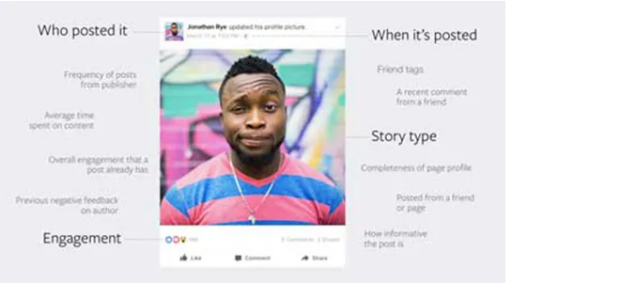
Source: Facebook
2. Create accurate and authentic content
Facebook says, “People on Facebook value accurate, authentic content.” They also specify that the types of posts people “consider genuine” will rank higher in the algorithm. Meanwhile, they work to reduce the ranking for posts people find “misleading, sensational, and spammy.”
Here are a couple of tips for signaling the algorithm that your content is accurate and authentic:
- Write clear headlines: Make sure your headline clearly describes what users will find in your post. You can certainly get creative with your post captions but don’t use clickbait or misleading titles.
- Be truthful: Put simply, tell the truth. Don’t sensationalize, exaggerate, or outright lie.
On the flip side, here are some things to avoid:
- Content that impedes community safety, like violence, self-harm, or use of regulated products.
- Content with low-quality health or financial claims, like miracle cures or get-rich-quick schemes.
- Unoriginal content or unattributed news content
- False claims and misinformation
- Facebook algorithm words to avoid, such as racist, homophobic, or violent language
3. Don’t try to manipulate the algorithm
But wait, isn’t this post all about how to manipulate the algorithm? No, this post is about understanding how the algorithm works so you can learn what Facebook considers valuable for its users.
It’s up to you to figure out how those overall principles apply to your specific audience. Then, create content that will resonate with them and send positive ranking signals to the algorithm.
Trying to manipulate the algorithm to get more distribution than your content merits is a big no-no. This might include paying for engagement or comments, or engaging in other black-hat strategies (or “inauthentic sharing”) to manipulate reach.
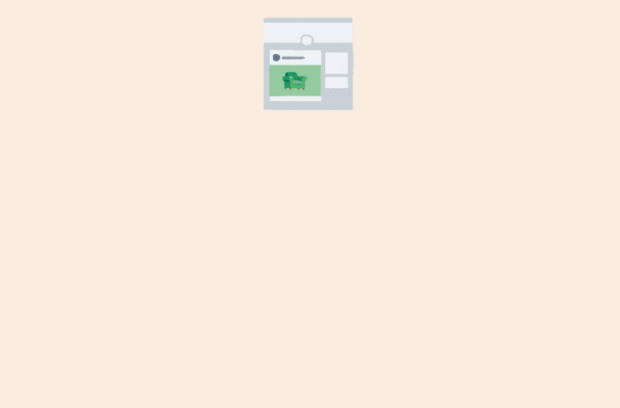
Source: Facebook
Facebook specifically works to limit the distribution of clickbait, engagement bait, and deceptive landing pages, so trying to manipulate the algorithm with these strategies will only work against you. Buying likes can also reduce your distribution.
As well, new feed preference controls give users more power to report, block, and hide content they feel is irrelevant. Even if Facebook’s moderators don’t catch you scamming, your audience likely will.
The simple message here: Work with the algorithm, not against it.
4. Engage with your audience
The algorithm Facebook uses prioritizes posts from Pages that a user has had meaningful interactions with in the past. This means that bumping up your reply game is key.
If a person takes the time to comment on your post, don’t waste the opportunity. Making them feel heard with a reply makes it more likely they will continue to comment on your posts in the future. This, of course, sends more of those juicy engagement signals to the algorithm. Ignore them and they’ll likely go silent in return.
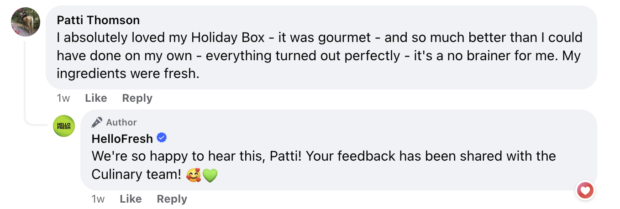
Pro tip: Whether you’re a solopreneur or you have a whole team of community managers in place, Hootsuite Inbox makes managing these conversations at scale a lot easier.
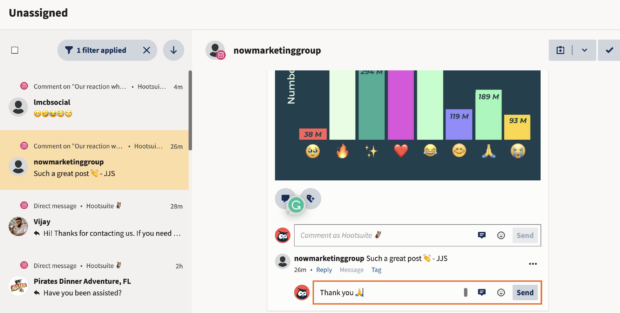
5. Get your audience to engage with each other
Remember how we said the algorithm values content that people want to share and discuss with their friends? Well, a pretty easy way to send that signal is to get people sharing your content and discussing it with their friends.
Facebook itself says that if a post triggers a lot of conversation among a user’s friends, the algorithm applies “action-bumping logic” to show that post to the user again.
To get your audience sharing and discussing, check out our tips for boosting Facebook engagement.
6. Post at the right time
Algorithm’s on Facebook help people see your content even if they weren’t online when it was first posted. But as we’ve emphasized throughout this post, engagement is a key signal that indicates a post’s potential value. And you’re most likely to get that engagement–especially critical early engagement–if you post when more of your audience is online.
Put simply, posting at the right time maximizes the chances that people will see your post, including people who are not online at the time you post!
Make sure you have a post up at the right time by using a Facebook auto-poster.
This is such an important topic that we’ve got a whole post dedicated to understanding the best time to post on Facebook.

As well, Hootsuite’s Best Time to Publish tool (built into Hootsuite Composer) and Hootsuite Analytics that will show you recommended times to share your next post to maximize engagement with your specific followers.
7. Don’t forget the basic status post
When you’re trying to bump up your engagement numbers, it can be tempting to seek out complicated Facebook algorithm hacks. But don’t forget the humble status post. (A post that has no photo, video, or link.)
Research from Hootsuite shows that status posts on average get among the highest engagement rates: 0.11%. Photo posts come in only marginally higher at 0.12%. Videos and link posts come in significantly lower at 0.08% and 0.04%, respectively.
We’re not saying you should create an entire Facebook Page of status posts, but they can be an effective way to communicate simple information and get top engagement scores.
8. Expand your reach via your best advocates
Your employees may have more credibility and authority with the Facebook algorithm than your brand page does. This is because they have more credibility and authority with their own followers and friends.
Your employees can exponentially expand your potential reach when they’re empowered to share your brand’s content to their own circles. Hootsuite Amplify can help make it easy for employees to share pre-approved content to their social channels.

Affiliate marketing is another great group of advocates that can help expand your reach and build your brand’s credibility. Give them resources and training to help them spread the word on Facebook and extend your targeted audience through their own algorithm signals.
9. Collaborate with influencers
Just as your employees can expand your reach, so too can influencers. Working with influencers who have a large and engaged following signals to the Facebook algorithm that your content is authoritative and relevant.
Before collaborating with an influencer, do your research to make sure they align with your brand and have an engaged following. This will ensure that their posts about your brand are genuine and resonate with their followers rather than coming across as inauthentic or forced (a bad signal to the algorithm).
10. Monitor analytics and Facebook insights
The best way to understand the Facebook algorithm is to track and measure your own performance. By monitoring analytics and insights, you can identify trends and patterns in engagement for your specific page.
You can then use this data to adjust and optimize your content strategy to better align with what resonates most with your audience.
Pro tip: Use Hootsuite Analytics to easily monitor Facebook post data and track your page’s performance over time. You can also compare your metrics to industry benchmarks to better understand how you stack up against competitors.
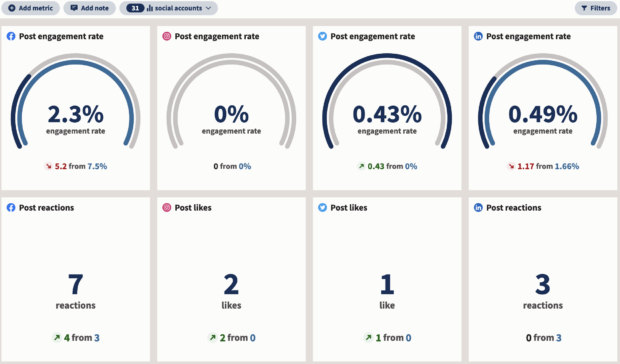
Get personalized recommendations for the best time to post on every network and manage your Facebook presence alongside other social channels with Hootsuite. From a single dashboard, you can schedule and publish posts, engage the audience, and measure performance. Try it free today.







